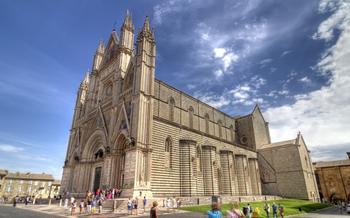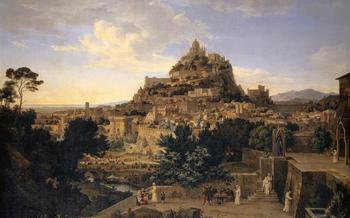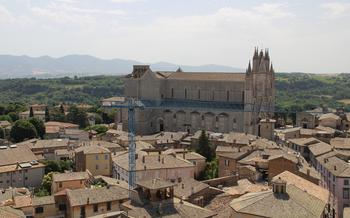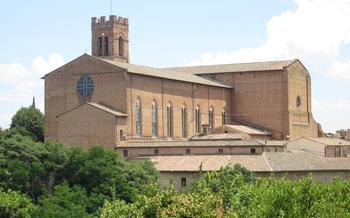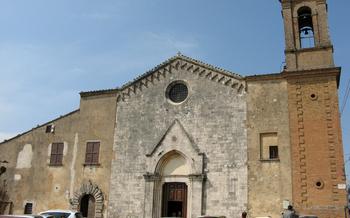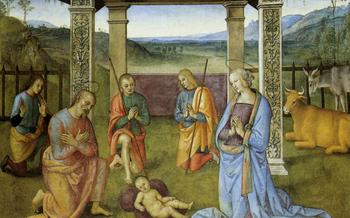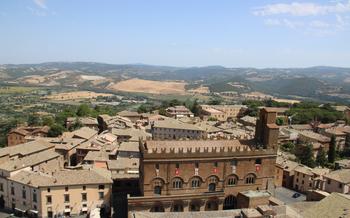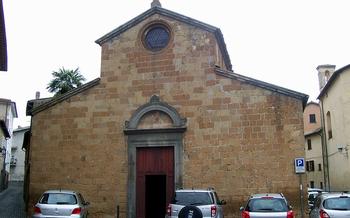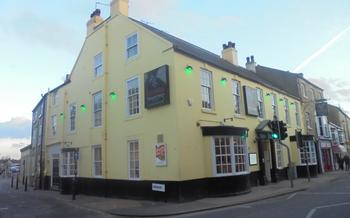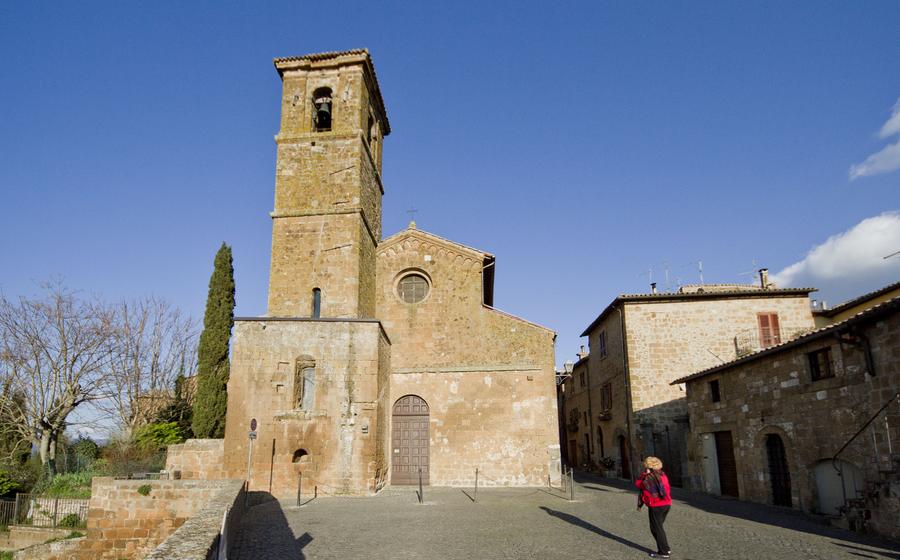
Chiesa di San Giovenale
- Introduction
- Exploring the Facade
- Stepping Inside: Discover the Awe-Inspiring Interior of the Chiesa di San Giovenale
- The Apse
- The Crypt: Unearthing the Hidden Treasures Beneath the Church
- The Surrounding Area: Exploring the Picturesque Surroundings of the Church
- Historical Context: Tracing the Origins and Evolution of the Chiesa di San Giovenale
- Restoration and Preservation: Safeguarding the Legacy of the Chiesa di San Giovenale
- Artistic Masterpieces
- Festivals and Events: A Vibrant Celebration of Faith and Culture
- Legends and Folklore
- Practical Information
- Recommended Itineraries
- Insider Tip: Unveiling the Hidden Splendors
Introduction
Nestled in the enchanting medieval town of Orvieto, the Chiesa di San Giovenale stands as a testament to the enduring legacy of early Christian architecture and art. Built in the 6th century, this hidden gem often overshadowed by its more renowned neighbor, the Duomo di Orvieto, is a treasure trove of historical significance. With its captivating facade, awe-inspiring interior, and hidden treasures beneath its surface, the Chiesa di San Giovenale beckons visitors to embark on a journey through time, faith, and artistic mastery.
History: The church's origins date back to the 6th century when it was commissioned by Bishop Eleuterio. Built atop an ancient Roman temple, the church was dedicated to Saint Giovenale, the first bishop of Orvieto. Over the centuries, the church underwent several transformations, blending architectural styles from early Christian to Renaissance and Baroque.
Architecture: The Chiesa di San Giovenale exemplifies the architectural transition from the austere simplicity of early Christian basilicas to the more ornate and decorative styles that would come to define later periods. Its simple yet elegant facade features a gabled roof, a rose window, and a series of blind arches, while the interior boasts a spacious nave flanked by two aisles, separated by rows of graceful columns.
Location: Situated in the heart of Orvieto's historic center, the Chiesa di San Giovenale is easily accessible on foot from the town's main square, Piazza del Duomo. Its strategic location, nestled among charming cobbled streets and historic buildings, makes it an integral part of the town's rich cultural fabric.
Key Features: Among the chiesa's most striking features are its intricate facade adorned with sculptures and reliefs, its awe-inspiring interior with its soaring columns and beautifully preserved frescoes, and its hidden crypt, home to ancient frescoes and archaeological findings.
Exploring the Facade
The facade of the Chiesa di San Giovenale is a masterpiece of Romanesque architecture, showcasing intricate details and profound symbolism. Its harmonious design features a blend of local materials, such as travertine and volcanic tuff, creating a rich and textured appearance.
The church's entrance is flanked by two impressive pilasters, topped with ornate capitals that display intricate carvings of human figures, animals, and mythical creatures. These carvings serve as a prelude to the symbolic journey that awaits visitors as they step inside the church.
The central focus of the facade is the rose window, a breathtaking circular stained glass masterpiece. The window depicts scenes from the Bible, narrating stories of faith, hope, and redemption. Its radiant colors and intricate patterns create a mesmerizing effect, drawing the viewer's gaze towards the heavens.
Surrounding the rose window are a series of bas-relief sculptures, depicting scenes from the life of Jesus Christ and the saints. These reliefs are not mere decorations but rather poignant reminders of the church's devotion and the power of faith.
The facade of the Chiesa di San Giovenale invites visitors to embark on a journey of discovery, deciphering the symbolic meanings embedded in its intricate carvings and sculptures. It is a testament to the artistry and devotion of the medieval craftsmen who created this enduring work of art.
Stepping Inside: Discover the Awe-Inspiring Interior of the Chiesa di San Giovenale
Stepping inside the Chiesa di San Giovenale is like stepping into a realm of sacred art and architectural wonder. The interior of the church is a symphony of intricate details, stunning artworks, and harmonious proportions.
The layout of the church follows a traditional basilica plan, with a nave flanked by two aisles, separated by rows of imposing columns. The nave is covered by a beautiful wooden ceiling, adding warmth and character to the space.
The church is adorned with a wealth of altars, each one a masterpiece in its own right. The high altar, located in the apse, is particularly impressive, with its intricate carvings and gold leaf decorations. The side altars are also adorned with beautiful paintings and sculptures, depicting scenes from the life of Christ and the saints.
The walls of the church are adorned with stunning frescoes and mosaics, which tell stories from the Bible and the lives of the saints. These artworks are a testament to the skill and devotion of the medieval and Renaissance artists who created them.
The church also boasts a collection of stained glass windows, which flood the interior with colorful light. These windows depict scenes from the life of Christ and the Virgin Mary, and add to the overall sense of awe and wonder inside the church.
The Apse
The apse of the Chiesa di San Giovenale is a masterpiece of medieval art and architecture. It is located at the eastern end of the church and is separated from the nave by a triumphal arch. The apse is decorated with a series of stunning mosaics that depict scenes from the life of Jesus Christ.
The mosaics were created by a team of skilled artisans in the 13th century. They are made up of millions of tiny pieces of colored glass and stone, which were carefully arranged to create intricate and lifelike images. The mosaics are a testament to the skill and artistry of the medieval craftsmen who created them.
The apse mosaics are arranged in three registers. The lowest register depicts scenes from the life of Jesus Christ, including his birth, baptism, and crucifixion. The middle register depicts scenes from the Old Testament, such as the creation of Adam and Eve and the story of Noah's Ark. The highest register depicts scenes from the New Testament, such as the resurrection of Jesus and the ascension of Mary into heaven.
The apse mosaics are a powerful reminder of the importance of the Christian faith in medieval Italy. They were created to inspire and awe the faithful, and they continue to do so to this day.
The Crypt: Unearthing the Hidden Treasures Beneath the Church
The Chiesa di San Giovenale holds a secret beneath its grand exterior—a crypt that invites visitors to journey back in time and discover hidden treasures. Unearthed in the 19th century, the crypt is believed to date back to the 6th century, revealing the church's ancient origins.
Step down into the dimly lit chamber and let your eyes adjust to the captivating sight of vibrant frescoes adorning the walls. These well-preserved paintings depict scenes from the Bible and lives of saints, offering a glimpse into the beliefs and artistry of early Christians. The vivid colors and intricate details transport visitors to a bygone era, immersing them in the sacred stories of old.
Beyond the frescoes, the crypt houses a collection of archaeological findings that shed light on the church's rich history. Discover ancient artifacts, fragments of pottery, and remnants of early Christian burials, each piece telling a story of the people who once worshipped within these walls.
The crypt of the Chiesa di San Giovenale is not just a hidden gem for history buffs but also a place of profound spirituality. In this sacred space, visitors can connect with the past and contemplate the enduring legacy of faith that has shaped this remarkable church.
The Surrounding Area: Exploring the Picturesque Surroundings of the Church
The Chiesa di San Giovenale is nestled in the heart of Orvieto's historic center, a treasure trove of medieval architecture and Renaissance art. Stepping out of the church, visitors are greeted by the charming Piazza del Duomo, a lively square dominated by the majestic façade of the city's cathedral. The piazza buzzes with activity, with locals and tourists alike enjoying the vibrant atmosphere, sipping coffee at outdoor cafés, or browsing the shops selling local crafts and souvenirs.
Beyond the piazza, a labyrinth of narrow cobblestone streets beckons exploration. Orvieto's historic center is a treasure trove of architectural gems, from ancient Etruscan ruins to medieval towers and palazzos. Visitors can wander aimlessly, discovering hidden courtyards, picturesque fountains, and charming boutiques. Must-see attractions include the Torre del Moro, a 13th-century watchtower offering panoramic city views, and the Pozzo della Cava, a fascinating underground well with a unique spiral staircase.
Orvieto is also renowned for its culinary delights. The city's restaurants serve up delicious Umbrian cuisine, featuring local specialties such as black truffles, wild boar, and handmade pasta. Visitors can indulge in a leisurely lunch at a traditional trattoria or savor a romantic dinner in one of the many rooftop restaurants overlooking the city's rooftops and the rolling hills of Umbria.
Historical Context: Tracing the Origins and Evolution of the Chiesa di San Giovenale
The Chiesa di San Giovenale holds immense historical significance, embodying various architectural styles and reflecting the changing religious and cultural landscape of Orvieto over the centuries. Its origins can be traced back to the early Christian period, when a small oratory was constructed on the site in the 5th century.
During the Middle Ages, Orvieto underwent a period of significant growth and prosperity, and the church was expanded and transformed into a larger basilica. The addition of intricate sculptures, bas-reliefs, and a magnificent rose window during the 13th century exemplifies the influence of Gothic architecture.
The Renaissance and Baroque periods brought further embellishments and modifications to the church. In the 15th century, the apse was adorned with a stunning mosaic depicting the Coronation of the Virgin Mary, a testament to the artistic prowess of the era. The interior was enriched with frescoes, paintings, and stained glass windows, creating a harmonious blend of Renaissance and Gothic elements.
In the modern era, the Chiesa di San Giovenale has undergone several restoration projects aimed at preserving its architectural integrity and artistic treasures. These efforts have ensured that this magnificent edifice continues to stand as a testament to Orvieto's rich history and enduring cultural legacy.
Restoration and Preservation: Safeguarding the Legacy of the Chiesa di San Giovenale
The Chiesa di San Giovenale has undergone several restoration projects throughout its history, each aimed at preserving its architectural integrity and artistic splendor. In the 19th century, extensive work was carried out to repair the church's facade, which had suffered damage from weathering and neglect. The original sculptures and reliefs were meticulously cleaned and restored, and the rose window was reconstructed using traditional techniques.
In the 20th century, a comprehensive restoration project focused on the church's interior. Frescoes and mosaics were cleaned and restored, revealing their vibrant colors and intricate details. The apse mosaic, which had been damaged over time, was painstakingly restored to its former glory. The church's crypt, which had been closed to the public for many years, was also restored and opened to visitors.
Today, the Chiesa di San Giovenale stands as a testament to the dedication and expertise of the artisans and conservators who have worked tirelessly to preserve its beauty for future generations. Ongoing conservation work ensures that the church remains a living testament to the rich history and artistic heritage of Orvieto.
Artistic Masterpieces
The Chiesa di San Giovenale is a treasure trove of artistic masterpieces that encapsulate different periods of art history. The church boasts a collection of frescoes by the renowned Renaissance painter Luca Signorelli, who adorned the apse with his vibrant and expressive depictions of scenes from the life of Christ. These frescoes are considered among his finest works and showcase his mastery of perspective and narrative storytelling.
Another highlight is the presence of sculptures by the celebrated medieval artist Arnolfo di Cambio. His delicate and intricate works, including the Madonna and Child, exude a sense of grace and serenity. The church also houses paintings by the Umbrian master Melozzo da Forli, known for his innovative use of perspective and his vibrant colors.
The stained glass windows of the church are equally impressive, with their intricate designs and rich hues. Many of these windows were created by Fra Angelico, a Dominican friar and renowned painter of the early Renaissance. His windows depict scenes from the life of Christ and the saints, and they illuminate the church with their ethereal light.
Festivals and Events: A Vibrant Celebration of Faith and Culture
The Chiesa di San Giovenale is not just a place of worship but also a stage for vibrant festivals and events that bring the community together and showcase the church's rich heritage.
During the annual feast day of San Giovenale, the church becomes the focal point of a grand religious celebration. The streets are adorned with colorful decorations, and a solemn procession carrying the statue of the saint winds its way through the historic center of Orvieto. Music, prayers, and heartfelt devotion fill the air as the community pays homage to their patron saint.
Beyond religious festivities, the church also hosts cultural events, music concerts, and historical reenactments. These events transform the sacred space into a vibrant stage, where performers bring to life the stories and traditions of Orvieto's past. From medieval reenactments to classical music concerts, there's something for everyone to enjoy at the Chiesa di San Giovenale.
One of the highlights of the church's cultural calendar is the annual Orvieto Musica Festival. This prestigious event attracts renowned musicians from around the world, who perform classical and contemporary pieces within the church's awe-inspiring acoustics. The festival offers a unique opportunity to experience the church's beauty while enjoying world-class musical performances.
Whether it's a religious procession, a cultural event, or a music concert, the festivals and events held at the Chiesa di San Giovenale offer visitors a chance to delve deeper into the church's history and embrace the vibrant spirit of Orvieto.
Legends and Folklore
The Chiesa di San Giovenale is steeped in legends and folklore that have captivated the hearts of locals and visitors alike. One poignant tale recounts the miraculous intervention of the church's patron saint, San Giovenale, during a siege by the Lombards in the 8th century. As the enemy forces encroached upon the city, the saint appeared in a vision to the bishop, urging him to lead a procession carrying the relics of San Giovenale around the city walls. Miraculously, the Lombard army was struck with blindness and confusion, causing them to retreat and abandon the siege.
Another legend speaks of a hidden treasure buried beneath the church. According to local lore, a wealthy and pious nobleman, grateful for his miraculous healing at the church, secretly buried a treasure trove of gold and jewels beneath the altar. The treasure's whereabouts remain a mystery, but the legend persists, fueling the imaginations of those who visit the church.
Throughout the centuries, the church has been a source of inspiration for storytellers and artists. Its unique architectural features and sacred atmosphere have served as a backdrop for countless tales of love, faith, and redemption. These legends and stories have become an intrinsic part of the church's allure, adding a layer of intrigue and enchantment to its already remarkable history.
Practical Information
-
Opening Hours and Admission Fees: The Chiesa di San Giovenale is generally open to the public from 8 AM to 7 PM daily. Admission is free, allowing visitors to explore the church's interior without any entrance charges.
-
Guided Tours and Accessibility: Guided tours of the church are available for a deeper understanding of its history and art. These tours typically cover the main highlights of the church, including the facade, apse, and crypt. For visitors with accessibility concerns, the church offers ramps and designated seating areas to ensure an inclusive experience.
-
Dress Code and Etiquette: As a place of worship, visitors are encouraged to dress respectfully when entering the church. Revealing or overly casual attire is not considered appropriate. Maintaining a quiet and contemplative atmosphere is expected to respect the sanctity of the space.
-
Photography and Videography: Photography and videography are generally permitted inside the church, provided they are for personal use only. Tripods and flash photography are not allowed to minimize disruptions and protect the church's artwork.
Recommended Itineraries
Half-Day Itinerary:
For a quick exploration of the church and its surroundings, consider a half-day itinerary. Begin by admiring the intricate facade of the Chiesa di San Giovenale, taking note of its sculptures and rose window. Proceed inside to marvel at the stunning frescoes, mosaics, and stained glass windows. Descend into the atmospheric crypt to discover ancient frescoes and archaeological findings. Conclude your visit with a leisurely stroll around Piazza del Duomo, soaking in the charm of Orvieto's historic center.
Full-Day Itinerary:
If you have more time, opt for a full-day itinerary to delve deeper into the church's history and artistic treasures. Start with a guided tour to gain insights into the church's construction, symbolism, and restoration efforts. Spend ample time exploring the interior, appreciating the intricate details of the frescoes and mosaics. Take advantage of the opportunity to climb the bell tower for panoramic views of Orvieto and the surrounding countryside. Conclude your day with a leisurely lunch at a local restaurant, savoring the flavors of Umbrian cuisine.
Multi-Day Itinerary:
For a comprehensive experience, consider a multi-day itinerary to fully immerse yourself in the wonders of Orvieto. Dedicate a full day to exploring the Chiesa di San Giovenale, including a guided tour, a visit to the crypt, and ample time to admire the artistic masterpieces. Explore the rest of Orvieto's historic center, visiting attractions such as the Duomo, the Palazzo del Popolo, and the Torre del Moro. Venture beyond the city walls to discover nearby attractions like the Etruscan necropolis of Crocifisso del Tufo or the picturesque hilltop town of Civita di Bagnoregio.
Combining with Other Nearby Attractions:
Orvieto's strategic location makes it an ideal base for exploring other destinations in Umbria and Tuscany. Consider combining your visit to the Chiesa di San Giovenale with a trip to Assisi, the birthplace of St. Francis, or a visit to the medieval hill town of Montepulciano. The region is renowned for its natural beauty, offering opportunities for hiking, cycling, and exploring charming villages nestled amidst rolling hills and vineyards.
Insider Tip: Unveiling the Hidden Splendors
For an unforgettable experience, venture into the sacristy of the Chiesa di San Giovenale, a hidden gem tucked away from the main tourist routes. This intimate space, reserved for the clergy, boasts an exceptional collection of medieval and Renaissance masterpieces. Marvel at the intricate frescoes depicting biblical scenes, the delicate carvings adorning the wooden furniture, and the shimmering gold leaf embellishing the altarpieces. The sacristy offers a glimpse into the profound devotion and artistry that shaped this sacred space.
Plan your visit to coincide with the annual Festa di San Giovenale, held on May 3rd, to witness the church's vibrant celebrations. Locals gather in traditional costumes, carrying the statue of the saint in a solemn procession through the historic streets of Orvieto. The town erupts in a kaleidoscope of colors, music, and festivities, creating an unforgettable atmosphere that encapsulates the spirit of this remarkable church.

